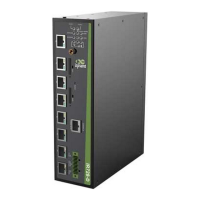64
relations between routers, to let any router’s routing changes will result in multiple
transmissions, which is not only unnecessary, but also wastes the precious bandwidth resources.
To solve this problem, OSPF protocol defines the "designated router" (DR) and “backup
designated router” (BDR).
OSPF protocol supports interface-based package authentication to ensure the safety of routing
calculation; and sends and receives package (224.0.0.5 and 224.0.0.6) by way of IP multicast.
9.2.3.3 Basic Concepts of OSPF Protocol
1. Autonomous System
It is a set of routers using the same routing protocols to exchange routing information and
abbreviated as AS.
2. Router ID
If a router wants to run the OSPF protocol, there should be a Router ID. Router ID can be manually
configured. If no Router ID is configured, the system will automatically select one IP address of
interface as the Router ID.
The selection order is as follows:
If a Loopback interface address is configured, then the laste configured IP address of Loopback
interface will be used as the Router ID;
If no LoopBack interface address is configured, choose the first configured IP address of other
interfaces will be used as the Router ID.
3. Protocol Package of OSPF
OSPF has five types of packets:
Hello Packet:
As the most common message, it is periodically sent to the router's neighbors. The contents include
the values of some timers, Designated Router (DR), Backup Designated Router (BDR) and the
known neighbors.
Database Description Packet (DD Packet):
When two routers conducts data synchronization, they will use DD packet describe their own LSDB.
The contents include the summary of each LSA in LSDB (summary refers to the LSA Header. The
Header can be used to uniquely identify an LSA). It is for reducing the amount of information
transmission among routers, because the LSA Header only accounts for a small portion of the entire
data size of an LSA. It can be judged from the Header that whether the router at the other end has
this LSA.
Link State Request Packet (LSR packet):
After mutual exchange of DD packet by two routers, it will be known that what LSAs of router at

